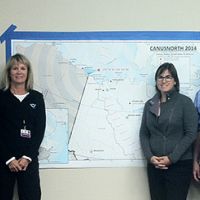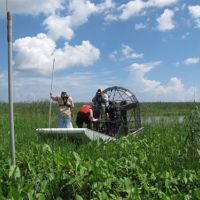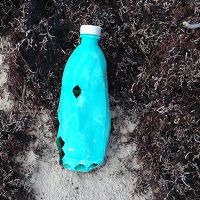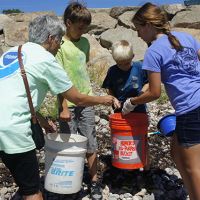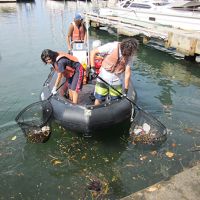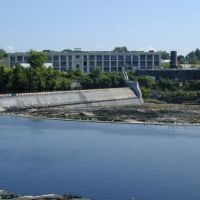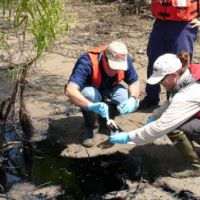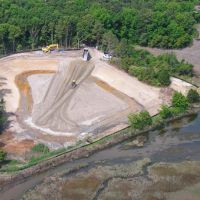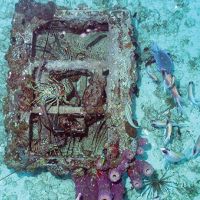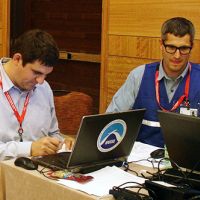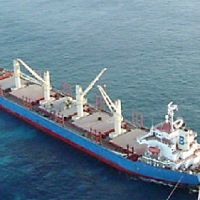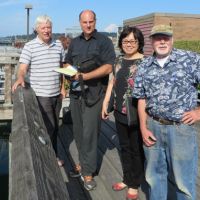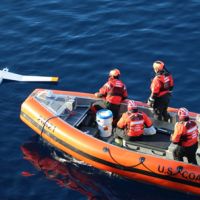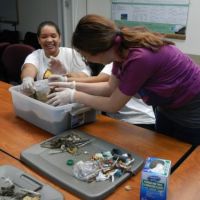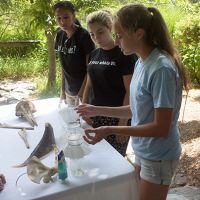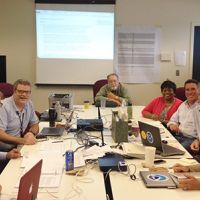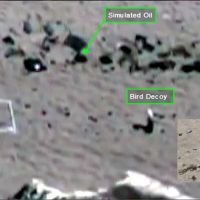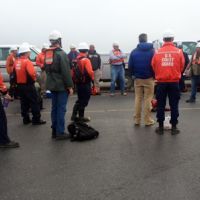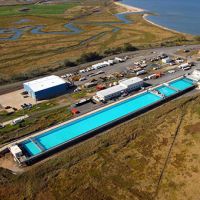JUNE 3, 2024 — On May 13, 2024, the United States District Court for the Western District of Washington finalized a settlement with Crowley Marine Services, Inc. (Crowley), 8th Avenue Terminals, Inc. and the Washington State Department of Transportation (WSDOT). The settlement is on behalf of the Elliott Bay Trustee Council, which includes NOAA, the U.S.
OR&R Weekly Report
The Office of Response and Restoration publishes this weekly round-up of news and information of interest to our partners, stakeholders, and team members. Click to subscribe
September 2014
As Arctic waters continue to lose sea ice each summer, oil-powered activity in the region will be on the rise—along with an increased risk of oil spills.
On December 27, 2012, Shell’s Arctic drilling unit Kulluk parted from its tow and grounded on Alaska’s Sitkalidak Island on New Year’s Eve. The rig had 138,000 gallons of diesel and other fuels and lubricants on board.
On September 9, 2014, the Science and Technology Subcommittee of the New Orleans Area Committee returned to the site of an in-situ burn which was conducted on June 3-4, 2014.
Kim Albins, Gulf of Mexico Regional Coordinator for NOAA's Marine Debris Program traveled to Austin and Corpus Christi Texas to “talk trash” with over 30 federal, state, and local partners last week.
Recently, NOAA's Marine Debris Program and Greater Atlantic Regional Fisheries Office held a staff picnic on at Stage Fort Park in Gloucester, MA.
OR&R presented at a forum on spills of heavy oils (Non-buoyant) hosted by the ISCO in Detroit on September 9, 2014.
The NOAA Marine Debris Program is a proud sponsor of the annual International Coastal Cleanup. This year, the cleanup is taking place on Saturday, September 20, 2014, across the globe from 9:00 a.m. to noon.
Dredging and capping/backfilling activities in the Upper Hudson River are destroying mussel beds and mussel habitat, which are not being replaced as part of the remedy for the Hudson River PCBs Superfund Site in New York.
The trustees recently issued the final plan for a study examining how freshwater mussel communities are affected by these activities.
OR&R's Emergency Response Division met with oil spill responders from California and the EPA to kick off a collaboration to develop a new handheld Shoreline Cleanup Assessment Technique (SCAT) data collection tool. When completed, this tool will greatly improve the speed and accuracy of field data collection during oil spills.
August 2014
OR&R Assessment and Restoration Division's Alyce Fritz was invited to participate in the Department of Defense, U.S. Environmental Protection Agency, and State Tier 3 Meeting held at EPA Headquarter offices in Arlington, Virginia last week.
She discussed collaborative interagency efforts to promote restoration success stories at Defense sites which are also Superfund sites.
On Wednesday, August 27, 2014, the NOAA Marine Debris Program hosted its first Marine Debris Prevention Projects Webinar.
Ninety participants engaged in marine debris prevention from across the country joined the call to learn more about education and outreach projects funded through the program's Marine Debris Prevention through Education and Outreach grants in FY 2013.
Like many regions of the United States, the Pacific Northwest has seen a massive surge in transportation of crude oil by rail, as well as oil train accidents, in recent years. The Assessment and Restoration Division is using spatial analysis to illustrate the intersection of railroads and sensitive habitats and species.
On the morning of August 20, 2014, Dr. Rob Campbell, oceanographer with the Prince William Sound Science Center, visited Shelter Bay in Alaska's Prince William Sound and took the 25th year of photos at this Office of Response and Restoration long-term monitoring site in connection with the Exxon Valdez oil spill.
Thousands of fishing traps are lost or abandoned each year in U.S. waters and become what are known as derelict traps, and result in losses to habitat, fisheries, and watermen who depend on these resources.
These losses are largely preventable, according to a new study released by the NOAA Marine Debris Program.
Along the banks of Oregon's Willamette River, NOAA and our partners, including a habitat development company called Wildlands, have started building habitat for fish and wildlife, just a few miles downriver from Portland, Oregon.
The week of August 18, 2014, the OR&R participated in a worst-case oil discharge exercise for the Shell Harbor Island Oil Terminal in downtown Seattle.
The exercise simulated a response to a spill of over 60,000 barrels of marine diesel oil from the Shell facility into the West Duwamish Waterway and Elliot Bay.
On August 15, 2014, NOAA and fellow Trustees, U.S. Fish and Wildlife Service and the State of Hawaii, working on the restoration of natural resources injured by the M/V Cape Flattery vessel grounding, released a Draft Damage Assessment and Restoration Plan/Environmental Assessment (Draft DARP/EA), opening a 30-day public comment period.
Hurricanes Gustav and Ike made landfall on September 1 and 12, 2008, respectively. High winds and waves associated with the passage of these storms caused a number of discharges of oil from damaged facilities, tanks, and pipelines along the coasts of Louisiana and Texas and in deeper waters offshore.
On August 18, 2014, OR&R Senior Scientist Alan Mearns met with two professors funded by NOAA Sea Grant to evaluate the economic benefits vs. environmental impacts of marinas and boat harbors.
The unique logistics of responding to an oil spill in the extreme and remote Arctic environment drive to the heart of why OR&R GIS specialists Jill Bodnar and Zachary Winters-Staszak are currently on board the U.S. Coast Guard Cutter Healy, at the edge of the sea ice north of Alaska.
On August 19, 2014, NOAA was very pleased to host students enrolled at the Native Youth Enrichment Program at the University of Washington.
The NOAA Marine Debris Program announced funding during the week of August 18, 2014, for 10 new Prevention through Education and Outreach partners across the country. The Marine Debris Program has provided $500,000 to launch these partnership projects ranging from education for fishers to social marketing and awareness campaigns.
Southern California residents lose millions of dollars each year avoiding littered, local beaches in favor of choosing cleaner beaches that are farther away and may cost more to reach, according to a new NOAA-funded Marine Debris Program economics study.
Two members of OR&R's Emergency Restoration Division attended a week-long training workshop at U.S. Coast Guard (USCG) headquarters in Washington, D.C. during the week of August 4, 2014.
This concoction was created in the Western Regional Center (Seattle) kitchen on August 13-14, 2014.
- 3 Emergency Response Division managers
- 1 seasoned NOAA labor management advisor
On August 4 - 6, 2014, representatives from OR&R’s Assessment and Restoration Division collaborated with staff from the Office of National Marine Sanctuaries, the Office of Marine and Aviation Operations (OMAO), and the Oceanic and Atmospheric Research UAS Program (UASPO) in an exercise to evaluate Unmanned Aerial Systems (UAS) for oil spill response and damage assessment activities.
The week of August 4, 2014, the annual Pacific Northwest Oil Spill Control Course (PNWOSCC) took place in Port Angeles, WA. PNWOSCC is a blend of classroom training and practical hands-on exercises in the methods of controlling, containing, and cleaning up oil spills on water and on shore.
During the week of August 4, 2014, as part of an ongoing effort to prepare for an oil spill in the Arctic, NOAA’s Office of Response and Restoration (OR&R) joined a team of researchers in Barrow, Alaska, to field test ephemeral data collection methods.
On August 8, 2014, OR&R marine biologist, Gary Shigenaka, and Dr. Adrian C. Bejarano, aquatic toxicologist, made presentations to a group of oil spill response professionals as part of the Science of Oil Spills class, offered by OR&R in Seattle this week.



